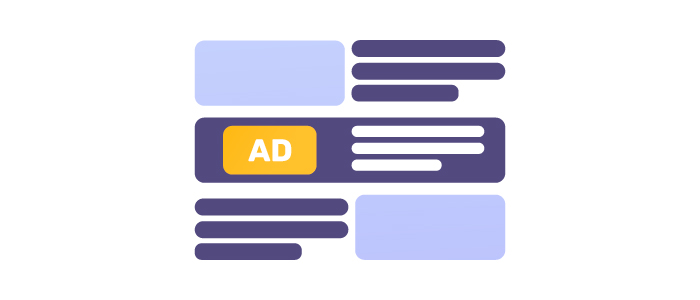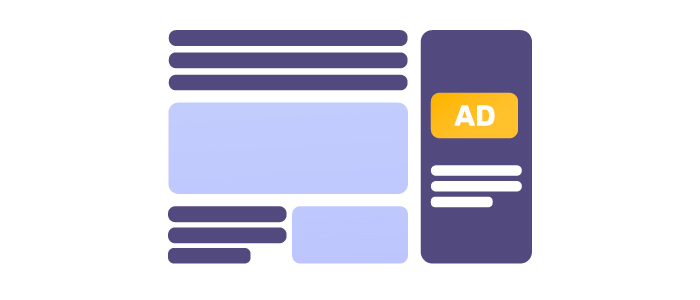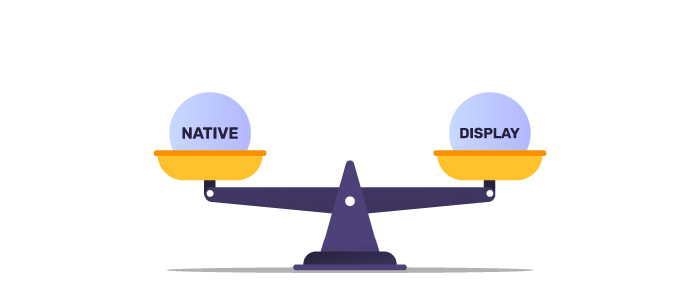Native Ads vs Display Ads: What, When and Where to Use Them
Are you interested in learning about the differences between native ads vs. display ads? You have come to the right place to discover what sets them apart and where each excels.
Native ads discreetly blend into the content as silent viewers, delivering their message without drawing too much attention. On the other hand, display ads boldly catch the eye with vibrant visuals, similar to the bright lights of a bustling city.
Understanding the differences between native and display ads can help create campaigns that resonate with your audience. Whether you prefer subtlety or boldness, you are ready to significantly impact the digital landscape.
Table of Contents
What Are Native Ads?

Native ads are a type of advertisement that blends in with the content of a web page, appearing alongside or at the end of articles. This concept emerged in 2011 and is quickly becoming more popular than display ads.
What makes native ads different from traditional ads is their editorial look and feel, which presents a softer selling approach that feels less intrusive than digital ads. You often see native ads as “promoted” or “sponsored” posts on reputable websites seamlessly integrated into the browsing experience.
The global native advertising market is projected to surpass US$ 650 billion by 2023 due to the increasing accessibility of smartphones and the Internet. Studies indicate that native ad campaigns outperform other digital channels, with consumers engaging with them 53% more frequently than display ads.
Successful native advertising depends on subtlety, aiming to engage and inform users without overtly pushing a product or service. By mirroring the site’s content’s tone, style, and format, native ads foster stronger connections with audiences, prioritizing relevance and authenticity. Advocates praise native ads for their creativity and minimal intrusion, integrating into websites to attract visitors without disrupting the flow of content.
The Interactive Advertising Bureau (IAB) classifies native ads into three formats: In-Feed/In-Content Units, Content Recommendation Ads, and Branded/Native Content. These ads vary in size and format, including video ads and recommendation blocks.
What Are Display Ads?

Display ads, or digital ads, come in various formats, such as banner ads, videos, and interactive pop-ups. While their click-through rates (CTR) are typically lower than other ad types, CTR is not the only measure of success.
Display ads are effective in boosting brand awareness and purchase intent. Initially called “banner ads,” they have evolved over almost three decades, adapting to changing web designs with video integration, interactive features, and pop-ups.
Display ads are powerful tools for promoting brands across various online platforms, including websites, emails, YouTube, and mobile apps. Although they may have lower click-through rates than native ads, they offer unique benefits.
Despite concerns about ad banner design blindness, where users ignore online ads, display ads remain compelling, especially in retargeting campaigns. As web design becomes more dynamic, display ads evolve, offering diverse formats like static, animated, video, and interactive ads.
Moreover, display ads are highly scalable, allowing businesses to reach a broad audience or target specific niche markets based on user preferences and browsing behavior. From static images to engaging animations and interactive elements, display ads offer various formats to achieve campaign objectives and reach different audience segments.
Native Ads vs. Display Ads At a Glance
| Aspect | Native ads | Display Ads |
| Approach | Soft sell blends with the surrounding content | Hard sell, noticeable as an ad. |
| CTR | High | Low |
| Traffic Quality | Campaigns usually generate quality traffic. | Campaigns on standard websites generate lower-quality traffic. |
| Cost per Click | More expensive. | Cheaper. |
| User Experience | Looks like editorial content. | It stands out as a paid ad. |
| Effectiveness | More effective on mobile. | More effective on desktop. |
| Ad format | Static with image and text. | Varies in shape and size to fit different locations on a webpage. |
| Purpose | Recommended or branded content. | Ideal for retargeting campaigns. |
| Ideal Use | Great for educating your audience. | Retargeting and direct response campaigns. |
Native and Display Ads: Key Differences

The key difference between native and display ads lies in their approach and integration within digital content.
Native ads adopt a subtler approach, more like a part of the user’s content experience. Unlike display ads, native ads aim for a smooth user experience without disrupting the content flow, which can sometimes be interrupted by bold designs and direct sales pitches.
Native ads focus on engagement, weaving into the content to capture users’ attention with their subtlety. This leads to higher click-through rates and more meaningful interactions. Display ads might catch the eye initially, but they can struggle to maintain interest, often resulting in lower engagement and click-through rates.
Native ads effectively attract discerning audiences by providing valuable content that feels integrated, while display ads target broader audiences, potentially less engaged but at a more accessible cost.
On mobile devices, native ads shine by seamlessly blending into the user experience, a feat that display ads can find challenging, especially on smaller screens.
Native ads are skilled at storytelling, integrating narratives into content to educate, entertain, and inspire action. Display ads, by contrast, seek to grab attention with visual flair and catchy slogans to prompt immediate action.
Native ads enhance the user experience by positively affecting brand perception. On the other hand, display ads can detract from the content and potentially damage the brand image if perceived as intrusive.
Native advertising offers diverse formats, such as in-feed ads and sponsored articles, tailored to specific audience segments and objectives. On the other hand, display ads include standardized formats like banners and pop-ups, suited for various creative approaches but often positioned outside the core content.
The Benefits of Native and Display Ads
Let us explore the advantages of native and display ads and see how they outshine other advertising methods.
Native Ads Benefits:
- Capturing Audience Attention: Native ads integrate with content, attracting viewers and engaging them with a format.
- Enhanced Performance: Native ads achieve high views, click-through rates, and conversions due to their natural integration and user-friendly content.
- Credibility: Native ads are tailored to user intent and perceived as more trustworthy, fostering consumer trust and loyalty.
- Targeting Optimization: Contextually targeted native ads provide a personalized experience, driving traffic and enhancing user engagement.
Display Ads Benefits:
- Targeted Reach: Display ads offer precise targeting options, ensuring ads reach relevant audiences based on demographics and interests.
- Visually Engaging Design: With graphics and video elements, display ads capture attention and stand out in crowded digital spaces.
- Retargeting Capabilities: Display ads enable retargeting of interested users, encouraging them to revisit and engage with the brand.
- Brand Awareness Boost: Display ads increase visibility, reinforcing brand presence and recognition among potential customers.
- Mobile Accessibility: Geofencing targets consumers on the go, capturing their real-time attention.
- Easy Tracking and Measurement: Display ads provide transparent metrics for tracking impressions and clicks, facilitating optimization for improved performance.
In summary, native and display ads offer unique benefits and cater to different advertising goals and strategies. Whether you prioritize engagement with native ads or precise targeting and visual impact with display ads, using both in your marketing mix can maximize your advertising effectiveness and drive success.
Native Ads vs. Display Ads: Functionalities
Native advertising is a powerful tool that enables ads to engage with content such as videos and articles. This enhances the user experience by feeling natural.
Native ads come in various formats, such as in-feed or sponsored content, tailored to different platforms and user preferences. With precise targeting capabilities, native ads ensure maximum impact by reaching the right audience based on demographics, interests, and browsing behavior.
On the other hand, display ads offer retargeting abilities, enticing users who have engaged with the brand to return and take desired actions. They boost brand visibility across online platforms, increasing exposure and awareness among potential customers.
Display ads also make it effortless to track campaign performance by providing valuable metrics like impressions, clicks, and conversions for informed decision-making and optimization.
Native Ads vs. Display Ads: Use Cases
In this section, we will explore some practical examples that illustrate the unique use cases of both native and display ads.
- Influencer Collaborations: Collaborating with influencers to create native content can help build trust and credibility among their audience.
- Educational Content: Use native ads to engage and inform audiences with valuable insights and knowledge.
- Authentic Storytelling: Native ads can be used for storytelling campaigns that authentically convey brand messages and captivate audiences.
- Display Ads Visual Impact: Display ads can leverage their striking visuals and rich media formats to grab attention and effectively deliver brand messages.
- Event Promotion: Promote events such as webinars or product launches with visually appealing display ads that drive registrations and ticket sales.
- Local Advertising: Display ads can target local audiences to promote businesses, events, or offers and drive foot traffic and conversions in specific areas.
When to Use Native Ads
Consider using native advertising if your audience wants to take specific actions after clicking on your ad, such as reading a blog post, signing up, or purchasing. Native advertising can be advantageous in several scenarios:
- Advertising on a Tight Budget: Native advertising is more cost-effective than display ads because of its higher click-through rate (CTR), resulting in lower costs per click (CPC) and actions. This makes it a budget-friendly option for achieving desired user engagement.
- Simplified Campaign Tracking: Native ads streamline campaign tracking and accountability, focusing on post-click conversions. This approach provides concrete evidence of performance, especially when targeting users with sequential ads to guide them through the conversion journey.
- Amplifying Brand Content: Native advertising addresses the challenges of limited reach on social platforms and slow search engine optimization. It allows brands to amplify their content on demand, reaching wider audiences and bypassing algorithmic limitations.
- Diversifying Campaign Strategies: While content marketing is valuable, effective campaigns require versatility. Native advertising offers diverse approaches beyond content promotion, ensuring tailored strategies that align with individual client needs.
When to Use Display Ads
Display advertising is a highly effective tool that can help extend your marketing campaign’s reach and impact. It allows you to measure viewability and create interactive banners, which can help capture your target audience’s attention. Here are some situations when display advertising can be particularly effective:
- Building Brand Awareness: If you need to boost your brand’s visibility, display ads can be a great option. Their bold and contrasting nature ensures a solid first impression with potential customers.
- Visual Marketing: Display ads work particularly well for products that rely on visuals, such as infographics, ebooks, and coupons. They are also ideal for consumer products that require minimal storytelling.
- Targeting Niche Audiences: Display ads are excellent at reaching smaller target audiences. Allowing audience segmentation based on interests can help reduce costs and ensure that your brand connects with the right customers.
- Retargeting: Display ads can be part of your retargeting strategy for users who have interacted with your brand before. They can help to re-engage your audience effectively, whether you are targeting online shoppers with abandoned carts or promoting paid content to those who have engaged with your free resources.
Native Ads vs Display: What is Best for You

In the ever-changing marketing world, native advertising has become very popular and has shown impressive results. However, display ads are still valid and should not be ignored. Deciding which approach to take for your next campaign is essential, as well as ensuring you have the right team to execute it.
Display ads are great for remarketing and direct response campaigns as they offer targeted outreach, impressive impressions, and unique reach, making engaging with a broad audience easy.
On the other hand, native ads are perfect for driving clicks and click-through rates, leading to increased site traffic and content consumption. They are also the ultimate tool for driving conversions and building brand loyalty, making them the go-to solution for fostering engagement and promoting content.
In today’s competitive market, getting consumers’ attention can be difficult. Although native ads blend in easily, display ads are still effective. Utilizing the unique strengths of both ad formats is essential to creating a successful advertising strategy.
Native and display ads can be valuable tools for supporting your overall marketing strategy. To maximize your marketing performance, they should be combined with other advertising formats like video, connected TV (CTV), audio, and display campaigns.
FAQ
Native advertising is a powerful tool that enables ads to engage with content such as videos and articles. This enhances user experience by feeling natural and unobtrusive. Native ads come in various formats, such as in-feed or sponsored content, tailored to different platforms and user preferences.
Display ads are online advertisements that can contain text, images, and clickable links. They direct customers to learn more about or purchase products. Display ads usually appear at the top, side, or within website content.
Both native and banner ads have distinct advantages, yet they also work together within campaigns. Banner ads have a higher visual impact, while native ads are excellent at seamlessly integrating the brand into trusted content, making them stand out amidst the surrounding environment.
Google ads and native ads are two distinct advertising formats, although Google does provide native advertising options within its advertising platform.
Final Thoughts
In the ever-changing world of digital advertising, the debate between native and display ads continues. Native ads blend in with the content they appear alongside, engaging subtly, while display ads stand out with bold visuals. However, the future is uncertain. Many marketers are now combining both formats, utilizing their unique strengths to enhance the effectiveness of their campaigns.